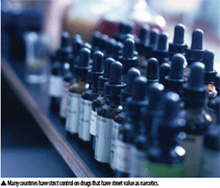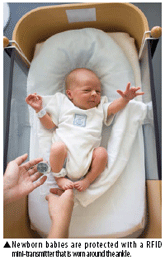Hospitals are very much like a large department store except there is no checkout counter,〃 said Nesbitt. They are loaded with big-ticket items, such as computers and medical apparatuses (endoscopy equipment, portable electrocardiogram devices, defibrillators and IV pumps). Both controlled and over-the-counter medications are also easy targets for off-the-street users. ¨In fact, one of the reasons things walk out of the hospitals is because the perpetratorsmostly employeesknow that their crime will most likely go unnoticed and undetected. Therefore, the best device is proper use and design of a card access system,〃 suggested Nesbitt.
General Asset Protection

¨Hospitals are very much like a large department store except there is no checkout counter,〃 said Nesbitt. They are loaded with big-ticket items, such as computers and medical apparatuses (endoscopy equipment, portable electrocardiogram devices, defibrillators and IV pumps). Both controlled and over-the-counter medications are also easy targets for off-the-street users. ¨In fact, one of the reasons things walk out of the hospitals is because the perpetratorsmostly employeesknow that their crime will most likely go unnoticed and undetected. Therefore, the best device is proper use and design of a card access system,〃 suggested Nesbitt.
The theft of medicine by drug addicts or for resale is an extremely serious and growing problem. Many countries have strict control on drugs that have street value as narcotics. "Hospitals should keep valuable drugs in separate cabinets,〃 said Thompson. ¨Depending on how the drug cabinet is constructed, you can either use traditional wireless access control readers or intelligent wireless locking hardware built right into the cabinet (a new trend). The key is not to just have it locked but to keep a record who and when accessed the cabinet and what they took. Security managers will also want to know whether the door was left open or forced. All traditional access control functions are appropriate.〃

More mobile equipment is easier to steal. Harris indicated an obvious trend: integration of RFID with video surveillance systems so that hospitals can monitor movement of high-value equipment and drugs. ¨A small active transmitter or tag is secured to the object. If the object crosses a certain line, the transmitter sends small RFID waves to readers, which are placed on the ceiling or above a door. The readers get signals and transmit position and identity of transmitter to a central server, which disseminates the aler t to emails , SMS , other systems via Ethernet, guards via radio communication or a bell,〃 explained Bietenholz.
¨Then, security guards follow the object from room to room,〃 he continued. ¨What we recommend is that when the object leaves the floor or staircase or if it enters the hallway, you close the door and shut down the elevator. Usually, fire codes prohibit this, so someone has to run after it.〃
The technology reduces shrinkage of highly mobile assets and eliminates time spent searching for assets for maintenance. ¨Hospitals, by law, have to do regular maintenance. Biomedical personnel may spend hours searching for one specific piece of equipment. If it has a tag, they could search on computer screens to locate the equipment,〃 said Bietenholz. It also streamlines inventory, reducing overstocking.
RFID Applications
RFID is an interesting application used in healthcare facilities. Other than asset tracking, it is used for panic buttons, nurse call, infant protection and patient walk-out detection. While panic buttons c an be wa l l -mounted or handheld, the idea l method, according to Bietenholz, is to have wireless RFID emergency buttons with all staff members equipped with badges featuring small transmitters. Alternatively, patients can wear nurse call wristbands with small active transmitters because ¨ the opportunity to go to the wall to press the button is not always guaranteed.〃
Discreet transmitters are easier to reach than conventional alarm buttons on walls. RFID panic buttons and nurse call bracelets work the same way as RFID asset tracking systems. ¨Readers placed on the ceiling or above a door forward position and identity of the transmitter to a central server, which sends alert messages to staff members through various channels. Or it could be programmed as a silent alert (vibration) to call a person so it does not escalate anxiety in already tense hospital environments.〃
¨Fortunately, infant abduction and mixing up of babies is rare in Europe. Nevertheless, it is on the increase,〃 said Bietenholz. Newborn babies are equipped with a tamper-proof miniature transmitter that is worn around the ankle. The baby can leave the ward only if carried by the mother or authorized staff member with the right transmitters, otherwise alarms are triggered. This provides protection from abduction as well as freedom of movement for mothers, visitors and nursing staff.
¨Some patients may leave their quarters inadvertently due to dementia, shock or because of heavy medication, thereby hur ting themselves.〃 RFID bracelets alert staff members as soon as monitored patients attempt to leave protected areas. ¨It is thus possible to keep doors open for visitors without having disoriented people leaving specified areas. This provides greater freedom for wandering patients without needing to lock down the site.〃
Integrated Management
Hospitals are ahead of other verticals in one respect: they are more likely than others to integrate security systems with communications and other systems. These integrations not only enhance physical and logical security, but they have clinical applications as well. Stentz identified miscommunication as the No. 1 driver of medical errors, which can result in harm to patients or even death. Integration between systems can improve communication and clinical outcomes. ¨The whole goal of integration is to provide a communication platform that can route alarms and events from any sourcesecurity systems, the patient monitor ing, etc. - - to any destination, using common standards and a common interface, " said Stentz. The platform "centralizes command and control in the hospital. Whether a door is forced ajar or a patient suffers a seizure, the information is available in real time via a familiar user interface, the alarm is routed appropriately, policies and procedures are enforced, and the event is logged for later review," she added.
For example, when a patient seizure occurs, the communication platform creates an "event file" that records everything about the event: what medical personnel responded, what actions were taken, and what drugs was administered.
¨It is almost like an airplaneˇs black box. The file includes not only medical information such as the result of a biopsy or radiology, but also all data from physical securitywhen a patient presses a nurse call button, CCTV footage, access control logs and pharmaceutical cabinet logs. Every data is streamlined into the electronic reference, then is turned into information."

This makes it possible to audit and review the entire event from start-to-finish. "The care giver gets a triangulated result to verify type of treatment for that patient. Hospital management can also use the record for continous improvement and to identitify opportunities to revise operating procedures,〃 added Stentz.
Bietenholz also believed that there will be more and more software-based care process management. When patients arrive, staff members enter their name and diagnosis; the software immediately records everything. ¨When care givers are at a patient bed, they have a wireless connection to files via laptops. When care givers prescribe drugs, it is done electronically so that there are no errors and no analysis is done twice. Hospital staff can reserve operating rooms, provide access control, and open pharmacy doors and automatic pill dispensers.〃
¨It is a bit like what SAP in factory production. The system supports the care process and equipment,〃 said Bietenholz. ¨I think that it is going to be the largest trend in optimizing and streamlining processes, including use of resources such as equipment and drugs. Care management processes will become more transparent, and this is going to affect accounting, equipment and secur ity because one can manage access for a given piece of equipment for a given time. One can also open and close doors based on case-by-case management. An electronic IP-based backbone or IP-based integrated care process will be the most important trend.〃
Staff Involvement
¨Security officers and security technology are not effective in a vacuum. When security equipment is used, it is important to understand the functional limits of the equipment. One of the most pervasive and inherent weaknesses of many security programs is employee apathy. If hospital employees believe that patients will be kept safe by the access control system coupled with CCTV, they are mistaken,〃 commented Nesbitt. The most effective security programas well as one of least expensiveinvolves full participation of all employees.
¨Remember, criminals want anonymity, and anonymity can be denied by engaged employees. Statistics and figures on healthcare security show that subsequent security expenditures result in far greater return on investment if employees are fully engaged. Ongoing security awareness programs increase the deterrent value of the bells and whistles.〃
More Information
Integrated Security in Healthcare: Part I